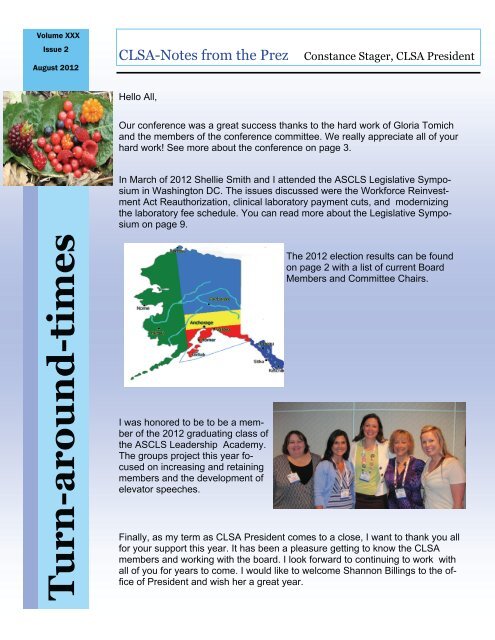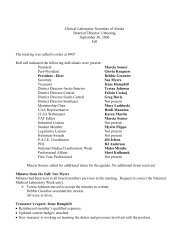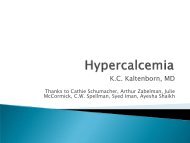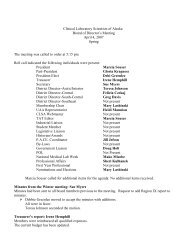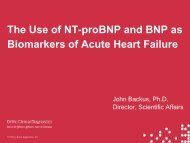August, 2012 - Clinical Laboratory Scientists of Alaska
August, 2012 - Clinical Laboratory Scientists of Alaska
August, 2012 - Clinical Laboratory Scientists of Alaska
Create successful ePaper yourself
Turn your PDF publications into a flip-book with our unique Google optimized e-Paper software.
Volume XXX<br />
From the<br />
Virtual Desk<br />
<strong>of</strong> the CLSA<br />
Issue 2<br />
<strong>August</strong> <strong>2012</strong><br />
CLSA-Notes from the Prez<br />
Constance Stager, CLSA President<br />
Hello All,<br />
Our conference was a great success thanks to the hard work <strong>of</strong> Gloria Tomich<br />
and the members <strong>of</strong> the conference committee. We really appreciate all <strong>of</strong> your<br />
hard work! See more about the conference on page 3.<br />
Changing Times<br />
In March <strong>of</strong> <strong>2012</strong> Shellie Smith and I attended the ASCLS Legislative Symposium<br />
in Washington DC. The issues discussed were the Workforce Reinvestment<br />
Act Reauthorization, clinical laboratory payment cuts, and modernizing<br />
the laboratory fee schedule. You can read more about the Legislative Symposium<br />
on page 9.<br />
Turn-around-times<br />
I was honored to be to be a member<br />
<strong>of</strong> the <strong>2012</strong> graduating class <strong>of</strong><br />
the ASCLS Leadership Academy.<br />
The groups project this year focused<br />
on increasing and retaining<br />
members and the development <strong>of</strong><br />
elevator speeches.<br />
The <strong>2012</strong> election results can be found<br />
on page 2 with a list <strong>of</strong> current Board<br />
Members and Committee Chairs.<br />
Finally, as my term as CLSA President comes to a close, I want to thank you all<br />
for your support this year. It has been a pleasure getting to know the CLSA<br />
members and working with the board. I look forward to continuing to work with<br />
all <strong>of</strong> you for years to come. I would like to welcome Shannon Billings to the <strong>of</strong>fice<br />
<strong>of</strong> President and wish her a great year.
<strong>2012</strong> Election Results<br />
Below are the current (<strong>2012</strong>-13) board members and committee chairs following the elections:<br />
Board Members<br />
President<br />
Shannon Billings<br />
President-Elect<br />
Past President<br />
Holly Berg<br />
Constance Stager<br />
Secretary Tony Gregston (2011-2013)<br />
Treasurer<br />
First Year Pr<strong>of</strong>essional<br />
Soh-Min Nee<br />
Shannon Albright<br />
Arctic/ Interior Region District Director Teresa Johnson (2011-2014)<br />
Central Region District Director Hayatte Obeidi (<strong>2012</strong>-2015)<br />
South Central Region District Director Susan Myers (<strong>2012</strong>-2015)<br />
South Eastern Region District Director Jeane Frickey (2011-2014)<br />
Western Region District Director Bill Doughty (2010-2013)<br />
Committee Chairs/others<br />
By Laws<br />
Government Liaison<br />
Historian<br />
Membership<br />
Shellie Smith<br />
David Pierce<br />
Alicia Morgan<br />
Mary Lashinski<br />
National Medical Lab Pr<strong>of</strong>essionals Week<br />
Nominations/Elections<br />
Nominations/Elections – Committee member<br />
Nominations/Elections – Committee member<br />
PACE Coordinator<br />
Asako Fisher<br />
Gloria Tomich<br />
Vivian “Sharlane” Donaldson<br />
William Powell<br />
Allison Theriault<br />
Physician Office Lab Liaison<br />
Pr<strong>of</strong>essional & Public Relations<br />
Scholarships<br />
Student Member<br />
Turn Around Times Editor<br />
UAA Representative<br />
Web Master/ Education Coordinator<br />
vacant<br />
Sheri Kulhanek<br />
District Directors<br />
Marisol Hamilton<br />
Constance Stager<br />
Heidi Mannion<br />
Michael DelMundo<br />
Page 2<br />
TURN-AROUND-TIMES
<strong>2012</strong> Conference Summary<br />
This years conference was held at the <strong>2012</strong> CLSA Annual Conference March 28,29<br />
&30, at the Sheraton Hotel in Downtown Anchorage.<br />
Some <strong>of</strong> the highlights:<br />
ASCLS President Catherine Otto gave the key note<br />
address on patient safety.<br />
We had 23 educational sessions We had about 135 attendees<br />
including the vendors. The registrations were about 100.<br />
We had 22 registered booths for the vendors.<br />
Our project this year was<br />
the Food Bank <strong>of</strong> <strong>Alaska</strong>.<br />
We gave over $1400 and<br />
250 pounds <strong>of</strong> food!<br />
Awards:<br />
Omicron Sigma<br />
First awarded in 1977, Omicron Sigma is the ASCLS President’s Honor Roll for Out<br />
standing Service. It provides lasting recognition <strong>of</strong> those dedicated members who volunteer<br />
their personal resources, time and energy to the ASCLS.<br />
• Gloria Tomich : Past President, Conference Chair<br />
• Teresa Johnson: Scholarship Committee Chair, District Director<br />
• Heidi Mannion: Licensure, UAA MLT Liaison<br />
• Jill Jefson: Conference Planning, Treasurer<br />
Key to the Future<br />
*This award serves to recognize and reward ASCLS members who have demonstrated their<br />
leadership potential to the organization, and to provide these members with structured mentoring.<br />
• Hayette Obeidi<br />
• So-Min Nee<br />
Member to the Year<br />
• Tony Gregston<br />
The ASCLS Member <strong>of</strong> the Year Award is sponsored each year to recognize a member <strong>of</strong><br />
the American Society for <strong>Clinical</strong> <strong>Laboratory</strong> Science who has contributed significantly to the<br />
field <strong>of</strong> clinical laboratory science and to the Society and who has, by outstanding example,<br />
inspired others. All nominees are recognized at the ASCLS Annual Awards ceremony where<br />
the recipient <strong>of</strong> this award is announced.<br />
Gold Nugget Award<br />
In appreciation for an organization’s contributions to CLSA and to<br />
the pr<strong>of</strong>essional growth <strong>of</strong> laboratory pr<strong>of</strong>essionals in <strong>Alaska</strong>.<br />
• Sysmex USA<br />
ISSUE 2 Page 3
<strong>Alaska</strong>’s Innovations in Quality Public Health <strong>Laboratory</strong> Practice<br />
Shellie Smith<br />
The quality <strong>of</strong> waived testing in <strong>Alaska</strong> had been <strong>of</strong> concern even before the Commission<br />
on Office <strong>Laboratory</strong> Accreditation (COLA) in 2011 published a white paper<br />
on waived testing “Federal Government Questions Quality in Waived Testing:<br />
The Hard Facts and What Can Laboratories Do Now?” Based on phone calls to<br />
the <strong>Clinical</strong> <strong>Laboratory</strong> Improvement Amendments (CLIA) inspector and the initial<br />
surveys for Certificate <strong>of</strong> Waiver Laboratories, it became evident that outreach to<br />
Physician Office Laboratories could be <strong>of</strong> great value to these entities. Finding the<br />
funds to support outreach activities, however, <strong>of</strong>ten becomes the critical most factor<br />
in the implementation <strong>of</strong> such a program.<br />
See the article at http://www.cola.org/docs/waived/whitepaper.pdf<br />
The funding for this outreach came at a most fortuitous time through the Association <strong>of</strong> Public Health<br />
Laboratories (APHL). In October 2011, APHL <strong>of</strong>fered grant opportunities for innovations in quality public<br />
health laboratory practice. After reviewing the grant proposal, it was decided this was a great opportunity<br />
for <strong>Alaska</strong> to reach out to the physician <strong>of</strong>fice labs and <strong>of</strong>fer them the opportunity to improve the<br />
quality <strong>of</strong> their testing programs in a positive learning environment. Even though this opportunity was<br />
available to all public health laboratories, other public health laboratories within ASCLS Region IX did<br />
not apply for this grant. The objectives <strong>of</strong> the outreach program were aligned with the requirements <strong>of</strong><br />
the grant so at the conclusion <strong>of</strong> the training participants would be able to:<br />
• find FDA test complexity levels for test systems on the internet<br />
• apply the CLIA requirements for waived testing<br />
• follow the manufacturer’s package insert<br />
• recognize the difference between built-in and external controls<br />
• identify an example <strong>of</strong> good laboratory practice<br />
• apply good laboratory practice when performing waived tests<br />
<strong>Alaska</strong> is a huge state and travel is very costly so in order to get “the most bang for our buck,” we decided<br />
to hold training in regional areas where travel is reliable and most affordable. Once the regional<br />
areas were identified, we wondered what incentives we could <strong>of</strong>fer that would make our targeted audience<br />
want to participate in training. We decided that holding training sessions at “site neutral” locations<br />
such as hotels that provided classrooms and catering, was a good first step. We held the sessions on<br />
the weekends, avoiding times that would take participants away from their normal busy work schedules.<br />
We provided them with a handy reference binder and a training agenda, other reference materials they<br />
could take away, and presented a selection <strong>of</strong> donated door prizes to lucky participants.<br />
Page 4<br />
TURN-AROUND-TIMES
A partnership was formed for the training sessions between the <strong>Alaska</strong> CLIA surveyor and the Regional<br />
CLIA surveyor serving as the faculty. Between the two surveyors, they had a wealth <strong>of</strong> personal knowledge<br />
and written training materials they could readily identify for their use. They utilized materials such as<br />
the state surveyor questionnaire, CMS CLIA brochure, manufacturer package inserts from most common<br />
tests employed in <strong>Alaska</strong> and CDC resource booklets such as “Ready, Set, Test”. Participants were encouraged<br />
and time was set aside during each session to make sure that participants could ask as well as<br />
get all their questions answered. At the end <strong>of</strong> the sessions, participants were given certificates <strong>of</strong> attendance.<br />
Marketing the program consisted <strong>of</strong> sending a letter <strong>of</strong> invitation and pr<strong>of</strong>essionally printed brochure to all<br />
<strong>of</strong> the waived laboratories and provider performed microscopy laboratories identified in the CLIA website<br />
for <strong>Alaska</strong>. This approach was so successful, that participants unfortunately had to be turned away from<br />
some <strong>of</strong> the classes.<br />
As a result <strong>of</strong> the grant, 52 laboratories received training that would help them to evaluate correctly the<br />
level <strong>of</strong> testing they were performing, identify good laboratory practice and employ this in their waived testing<br />
programs, and the critical importance <strong>of</strong> following the manufacturer’s package insert. A pre and post<br />
test was used to measure the effectiveness <strong>of</strong> the training as well as a final evaluation that was sent out<br />
after all training sessions had been conducted. The final evaluation is in process and will be used to determine<br />
what practices were changed and how quality in waived laboratory testing improved as a result <strong>of</strong> the<br />
face to face training sessions. Pre and post test evaluations indicate that participants did learn and take<br />
away valuable information as a result <strong>of</strong> their participation.<br />
In the future, we hope to incorporate a distance learning component to the training so that more laboratories<br />
can participate in an asynchronous learning environment. We hope that APHL will <strong>of</strong>fer the grant<br />
again in the future and that more public health laboratories will take advantage <strong>of</strong> this opportunity to provide<br />
outreach at a time when budgets are shrinking. Course evaluations overwhelmingly support this<br />
learning opportunity and all participants were eager to recommend this course to their colleagues.<br />
Shellie Smith<br />
Region IX Director<br />
ISSUE 2 Page 5
Public Health Laboratories: Protecting Communities through Innovation,<br />
Leadership and Quality <strong>Laboratory</strong> Science<br />
Shellie Smith<br />
Many years ago, I started my career as a medical laboratory scientist in an acute care laboratory.<br />
Many <strong>of</strong> my student rotations had been in acute care laboratories and it seemed that was the direction I<br />
must take as I started my career in laboratory science. One day I was asked to send specimens over<br />
to the public health laboratory for testing. I was surprised. I had never heard <strong>of</strong> the public health laboratory<br />
and I had no idea what it did. Little did I know that someday I would work in one, and how<br />
amazed I would be as I learned more about the mission <strong>of</strong> this incredible healthcare partner. Shortly<br />
after I transitioned to working in <strong>Alaska</strong>’s public health laboratory, I began to see the important role<br />
Public Health Laboratories play in protecting communities through innovation, leadership and quality<br />
improvement.<br />
I have found it personally rewarding to be involved as our laboratory explores innovative ways to take<br />
new technology, such as molecular testing, and apply it to the needs <strong>of</strong> populations previously not<br />
served or underserved. In 1999, the Centers for Disease Control and Prevention (CDC), in partnership<br />
with the Association <strong>of</strong> Public Health Laboratories (APHL) and the Federal Bureau <strong>of</strong> Investigation, established<br />
the framework for a national <strong>Laboratory</strong> Response Network (LRN), whose objective is to ensure<br />
an effective, coordinated laboratory response to bioterrorism. As LRN members, public health<br />
laboratories throughout the nation implemented molecular methods for the detection <strong>of</strong> microbes that<br />
had potential to be used for intentional harm. But how can technology developed for bioterrorism preparedness<br />
help solve a real life problem for an underserved population?<br />
In <strong>Alaska</strong>, specimens submitted to the public health laboratory may be in transit for several days due to<br />
vast distances and extreme weather conditions. This was especially problematic for pertussis cultures<br />
from suspect outbreaks in rural parts <strong>of</strong> the state where microbiology services are not available. While<br />
children appeared clinically sick and pertussis was suspected, healthcare providers could not confirm<br />
this by laboratory diagnosis, nor could they determine the scope <strong>of</strong> the disease in the community without<br />
laboratory surveillance data. The organism was too fragile to survive transit and even though pertussis<br />
culture was the gold standard in laboratory testing, it just didn’t work for <strong>Alaska</strong>’s rural populations.<br />
Using expertise acquired from the LRN testing, <strong>Alaska</strong>’s public health laboratory staff was able<br />
to validate a molecular methodology that allows rapid diagnosis <strong>of</strong> this disease in specimens containing<br />
non-viable organisms. Now all <strong>of</strong> <strong>Alaska</strong>n children have access to speedy and accurate pertussis testing<br />
no matter where they live.<br />
Recently I have been involved in a project that illustrates how the public health laboratory expands its<br />
role beyond diagnostic and surveillance testing to provide scientific and managerial leadership for the<br />
development <strong>of</strong> public health policy. As a regional advisory committee member on an infertility prevention<br />
project, I actively promoted implementation <strong>of</strong> the most reliable sexually transmitted disease testing<br />
(STD) methodology for the region. I worked collaboratively with local, state, regional and federal laboratory<br />
partners as well as industry to develop policies to lower the per patient testing cost. This was<br />
accomplished by pooling specimens without sacrificing quality; providing and reviewing statistics to<br />
concentrate limited resources on achieving overall regional goals for detection and treatment; identifying<br />
expert witnesses on the use <strong>of</strong> this testing methodology for forensic testing and court testimony;<br />
and recommending the appropriate use <strong>of</strong> this STD testing methodology.<br />
<strong>Alaska</strong>’s public health laboratory seeks to promote quality lab science internally by incorporating quality<br />
improvement into all daily activities <strong>of</strong> the laboratory whether these activities are for research, surveillance<br />
or diagnostic purposes. As an example, in spite <strong>of</strong> severely limited resources, the laboratory was<br />
recently able to develop a nucleic acid amplification test for rapid detection <strong>of</strong> Mycobacterium tuberculosis<br />
(MTB) complex. Traditional culture methods are still used, but the availability <strong>of</strong> the new molecular<br />
test greatly improves diagnostic services to many patients by cutting the detection time from a long<br />
one to eight weeks down to a very short three to five hours.<br />
Page 6<br />
TURN-AROUND-TIMES
Our laboratory promotes quality science outside our doors as well. Infection control programs in<br />
<strong>Alaska</strong>’s healthcare and public education facilities have improved through the use <strong>of</strong> Pulse Field Gel<br />
Electrophoresis (PFGE) performed at the public health laboratory. PFGE analysis is a useful tool for<br />
examining the source and spread <strong>of</strong> pathogenic bacteria such as methicillin-resistant Staphylococcus<br />
aureus (MRSA), a constant infection control threat. I am consistently encouraged by the willingness <strong>of</strong><br />
the public health laboratory to be a resource to other laboratory’s quality improvement endeavors. In<br />
an effort to see that the transporters are safe and the specimens arrive intact, I have committed many<br />
hours to teaching <strong>Alaska</strong>’s private healthcare providers how to properly ship specimens. Our public<br />
health laboratory is a ready source <strong>of</strong> previously tested specimens that private clinical laboratories can<br />
use to verify or validate new testing methodologies thus improving the laboratory science used to<br />
serve their patient populations.<br />
I have shared with you some <strong>of</strong> my fulfilling experiences working in a single public health laboratory.<br />
However, each state public health laboratory operates within the parameters <strong>of</strong> its mission and the<br />
boundaries <strong>of</strong> its jurisdiction. There are similarities across all states, just as there are unique differences<br />
between them. Although the general public or even many clinical laboratory scientists may<br />
know little about them, all public health laboratories strive to protect communities by promoting innovative,<br />
quality, laboratory science. I am pleased to work among these dedicated laboratory pr<strong>of</strong>essionals.<br />
The views expressed are those <strong>of</strong> the author only and do not necessarily reflect the views <strong>of</strong> any individual<br />
public health laboratory, the Association <strong>of</strong> Public Health Laboratories (APHL), or the State <strong>of</strong><br />
<strong>Alaska</strong>.<br />
Need some help recruiting new members?<br />
Membership<br />
ASCLS has the recruitment materials you need! Take advantage <strong>of</strong> the ASCLS Leadership<br />
resources found at http://www.ascls.org/?page=State_Lead_Area<br />
On this page you will find:<br />
• Recruitment Documents<br />
• Member Recruitment PowerPoint <strong>2012</strong><br />
• What to Say When You Don’t Know What to Say<br />
• Graduating Student Recruitment Letter Sample<br />
• Recruitment Guide to Moderators<br />
• Keep in Touch Cards<br />
• Business Cards-ASCLS Logo<br />
Issue 2 Page 7
Student Perspective<br />
… from CLSA Student Representative Marisol Hamilton<br />
Ashley<br />
Bender<br />
Student Report<br />
Shakira<br />
Leal<strong>of</strong>i<br />
In between studying and taking exams, the students at UAA celebrated lab<br />
week in high style this year. Showing <strong>of</strong>f their creativity, students participated<br />
in activities through out the week such as chrome agar art, design<br />
your own lab coat and what not to wear in the lab!<br />
The lucky first place titles went to Ashley Bender for her sporty beachwear, Rebecca Lewis’ rendition <strong>of</strong> Van<br />
Gough’s “Starry Night” and Shakira Leal<strong>of</strong>i’s one <strong>of</strong> a kind lab coat.<br />
Rebecca Lewis<br />
On May 4th, <strong>2012</strong> the UAA MLT department hosted a pinning ceremony for the students who completed their<br />
program. Congratulations to the following for their accomplishment:<br />
OEC Phlebotomy<br />
Medical Technology<br />
Eric Anderson Sarah Martin Dawn Boullion<br />
Corey Chivers Julie Moua<br />
Jeremy Foss<br />
Cody Putnam<br />
Alix Graves<br />
Caitlin Richardson<br />
Katie Haag<br />
Daisy Richmond<br />
Shannon James James Rising<br />
Madeline Knoll Elaine Tacaca<br />
Mary Grace Villasin<br />
Finally the MLT club has extra “Streaking, its what we do” t-shirts available for<br />
purchase for anyone who would like one. Price per shirt is $15.00. If you<br />
are interested please email me at mdhamilton2@alaska.edu.<br />
ISSUE 2 Page 8
<strong>2012</strong> Legislative Symposium Constance Stager<br />
This year’s Legislative Symposium was March 19 th and 20 th in Washington DC. Representatives from<br />
ASCLS, ASCP, AMT, ACLA, and CLMA were all present at the conference to lobby for issues <strong>of</strong> importance<br />
to Laboratorians.<br />
Representatives from all regions <strong>of</strong> ASCLS are brought together and provided an education on the howto's<br />
<strong>of</strong> lobbying. Attendees are coached on presentation techniques so they can effectively talk to their congressional<br />
representatives during their appointments. They are very well received in the congressional <strong>of</strong>fices<br />
and attendees return home from Washington with first-hand knowledge <strong>of</strong> the political system in action<br />
and confidence that they make a difference.<br />
Issue Briefings<br />
*Workforce Reinvestment Act Reauthorization<br />
*Modernizing the <strong>Laboratory</strong> Fee Schedule<br />
*Oversight <strong>of</strong> <strong>Laboratory</strong> Developed Tests<br />
Training programs<br />
Over the last two decades, our nation’s ability to train new laboratory practitioners has declined markedly.<br />
National Accrediting Agency for <strong>Clinical</strong> <strong>Laboratory</strong> Sciences (NAACLS), reports that the number<br />
<strong>of</strong> accredited medical laboratory technology programs, programs that train medical laboratory scientists<br />
and technicians, dropped from 709 in 1975 to 229 in 2011. Further, 7 Medical <strong>Laboratory</strong> Scientist programs<br />
and 17 Medical <strong>Laboratory</strong> Technician programs across 20 states are at risk for closure this year.<br />
Workforce Investment Act (WIA) Reauthorization<br />
The reauthorization would maintain Department <strong>of</strong> Labor workforce funding levels at the FY 12 level<br />
($2,605,268,000) to sustain the health related workforce programs. The reauthorized WIA would continue<br />
provisions that support the expansion <strong>of</strong> 2 and 4 year laboratory training programs at the community level.<br />
<strong>Clinical</strong> <strong>Laboratory</strong> Payment Cuts<br />
Reimbursement rates for laboratory services<br />
threaten our ability to meet the needs <strong>of</strong> physicians<br />
and patients, for not only seniors but for all<br />
Americans. Cuts mean we cannot hire qualified<br />
individuals to perform and interpret tests, integrate<br />
new science into medicine, and keep the<br />
hundreds <strong>of</strong> hospital, community and regional<br />
laboratories across the United States that provide<br />
these services open.<br />
Modernizing the <strong>Clinical</strong> Diagnostic <strong>Laboratory</strong><br />
Fee Schedule<br />
This fee schedule has not had a fundamental review since it was established in 1984. Accordingly, significant<br />
technological advances in the delivery <strong>of</strong> clinical laboratory services in the last 25 years are not<br />
fully reflected. Unless the fee schedule is modernized, patient access to health care is at risk and shortages<br />
in qualified personnel are anticipated. It is time to modernize the clinical diagnostic fee schedule<br />
to reflect both increased costs and current technology.<br />
Page 9<br />
TURN-AROUND-TIMES
CLINICAL LABORATORY<br />
SCIENTISTS OF ALASKA<br />
Turn Around Times Editor<br />
Constance Stager<br />
4734 Palo Verde<br />
Fairbanks AK 99709<br />
Printing & Postage Provided<br />
by <strong>Alaska</strong> Scientific, Inc.<br />
We’re on the WEB!!!<br />
State www.clsaonline.org<br />
Regional www.ASCLSR9.org<br />
National www.ascls.org<br />
Also: Check us out on Facebook!<br />
Inside This Issue:<br />
Notes From the Prez 1<br />
<strong>2012</strong> Election Results 2<br />
Conference Summary 3<br />
<strong>Alaska</strong>’s Innovations in Quality Public Health<br />
<strong>Laboratory</strong> Practice 4-5<br />
Public Health Laboratories: Protecting Communities through<br />
Innovation, Leadership and Quality <strong>Laboratory</strong> Science 6-7<br />
Student Perspective 8<br />
<strong>2012</strong> Legislative Symposium 9<br />
Activities <strong>of</strong> Region IX Student Representative 9<br />
Dates to Remember:<br />
<strong>2012</strong> NWMLS October 17 - 20 Portland, OR


